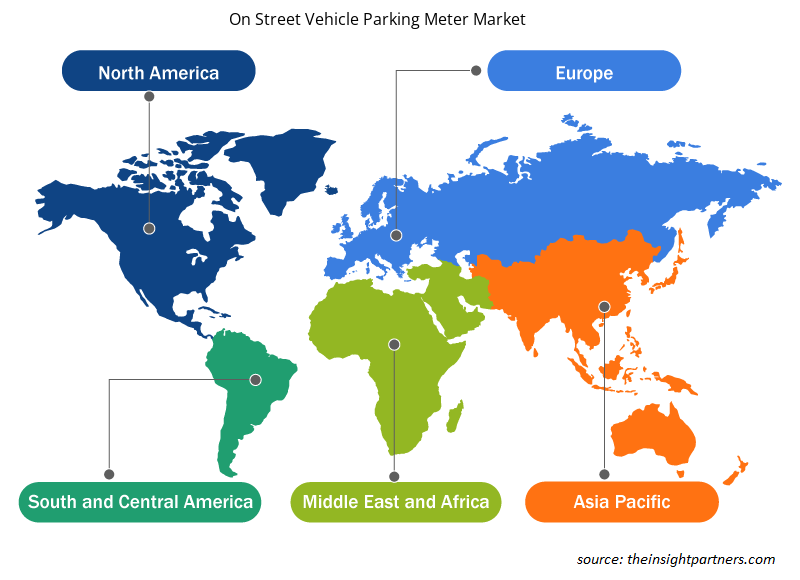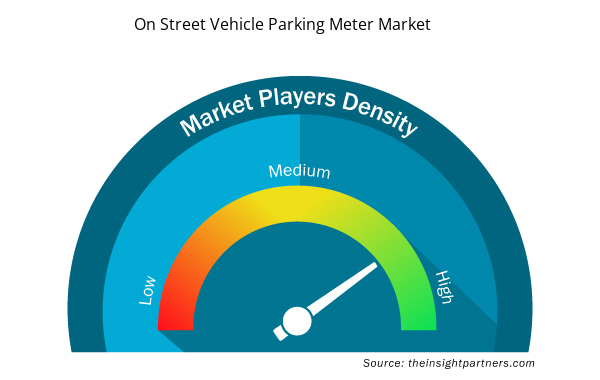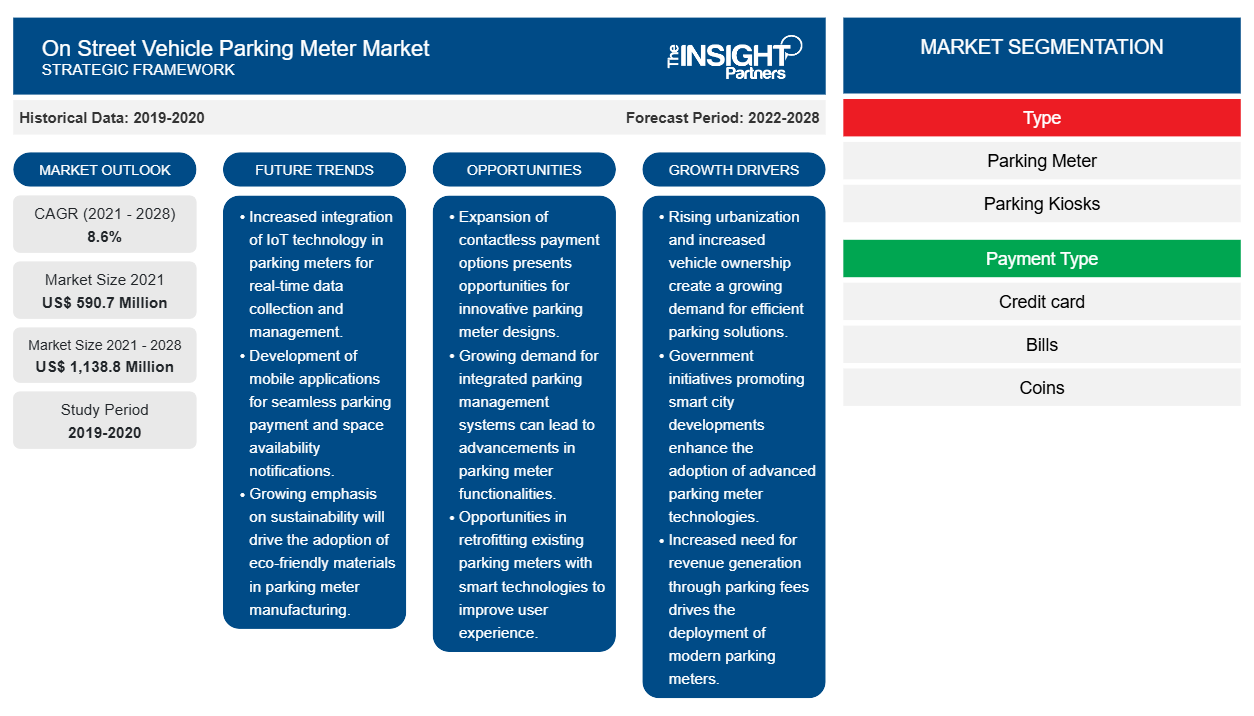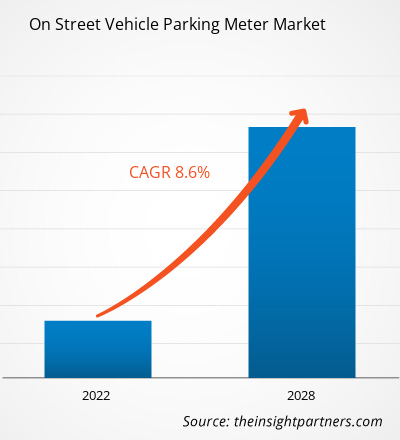Se espera que el mercado de parquímetros de vehículos en la calle crezca de US$ 590,7 millones en 2021 a US$ 1.138,8 millones en 2028; se estima que registrará una CAGR del 8,6% entre 2021 y 2028.
La creciente congestión vehicular y el aumento del número de automóviles están impulsando el crecimiento del mercado de parquímetros para vehículos en la vía pública. Estos parquímetros para vehículos se instalaban tradicionalmente en áreas de estacionamiento público para gestionar el tráfico y garantizar que el público pudiera encontrar espacios para estacionar cuando visitaba la ciudad. Hoy en día, las máquinas expendedoras de billetes de estacionamiento se encuentran en aparcamientos privados. Estas sirven como herramienta tanto para la generación de ingresos como para la facilidad de estacionamiento. En los últimos tiempos, el parquímetro para vehículos en la vía pública viene con funciones avanzadas. Por ejemplo, IEM SA ofrece PrestoInteractif (parquímetro inteligente avanzado) que tiene la capacidad de cargar las baterías con la ayuda de energía solar. El sistema consta de una gran pantalla táctil de 7", el parquímetro ofrece una interfaz altamente reactiva y fácil de usar. Y es compatible con una plataforma basada en la nube para fines de pago de proveedores externos. Además, el parquímetro para vehículos en el sitio ofrece todo tipo de opciones de pago, incluidas monedas, tarjeta de crédito/débito, tarjeta inteligente, fichas, pago por teléfono y pago NFC/sin contacto opcional.
El mercado global de parquímetros para vehículos en la vía pública está segmentado por tipo, tipo de pago y regiones geográficas. Según el tipo, el mercado de parquímetros para vehículos en la vía pública se segmenta en parquímetros (de un solo espacio) y quioscos de estacionamiento (de varios espacios). De manera similar, según el tipo de pago, el mercado se segmenta en tarjetas de crédito, billetes y monedas. Geográficamente, el mercado global de parquímetros para vehículos en la vía pública está segmentado en América del Norte, Europa, Asia Pacífico (APAC), Oriente Medio y África (MEA) y América del Sur (SAM).
Personalice este informe según sus necesidades
Obtendrá personalización en cualquier informe, sin cargo, incluidas partes de este informe o análisis a nivel de país, paquete de datos de Excel, así como también grandes ofertas y descuentos para empresas emergentes y universidades.
- Obtenga las principales tendencias clave del mercado de este informe.Esta muestra GRATUITA incluirá análisis de datos, desde tendencias del mercado hasta estimaciones y pronósticos.
Impacto de la pandemia de COVID-19 en el mercado de parquímetros para vehículos en la vía pública
La pandemia de COVID-19 ha provocado interrupciones en las industrias de estacionamiento debido a las restricciones en los viajes interurbanos y las operaciones de oficina; la proporción de vehículos por estacionamiento es escasa. Una fuerte disminución en el crecimiento de los usuarios de estacionamiento debido a la pandemia ha retrasado o pospuesto la inversión planificada para la gestión de estacionamiento, lo que redujo el crecimiento del mercado de parquímetros de vehículos en la calle. Sin embargo, se ha puesto de relieve la importancia de los pagos digitales en los parquímetros y la necesidad de un sistema automatizado de estacionamiento en la calle, lo que ha creado una oportunidad de crecimiento lucrativa para el mercado.
Perspectiva del mercado
Crecimiento rápido de la urbanización
El aumento de la población en las ciudades ha impulsado la venta de vehículos. Con el aumento de los ingresos disponibles, la población está ansiosa por tener sus propios vehículos para los desplazamientos diarios. El rápido crecimiento de la urbanización con el aumento de la venta de vehículos ha llevado a una mayor adopción de soluciones de gestión de aparcamientos inteligentes. La necesidad de parquímetros inteligentes para gestionar de forma eficiente los espacios de estacionamiento disponibles ha impulsado el crecimiento del mercado. Según los informes de la ONU, se supone que la urbanización en Europa aumentará en un 83,7% aproximadamente para 2050. Además, según la AEMA, el 75% de la población de la UE prefiere vivir en zonas urbanas. Por lo tanto, estos factores impulsan el crecimiento del mercado de parquímetros de vehículos en la calle para facilitar los métodos de pago del estacionamiento.
Información sobre segmentos de tipo
Los parquímetros para vehículos en la calle están diseñados para resolver los problemas de estacionamiento que se producen en las localidades urbanas. Los problemas de estacionamiento han sido un problema creciente en las ciudades, ya sean desarrolladas o en desarrollo. Por lo tanto, para simplificar la operación de estacionamiento en la calle, la demanda de un parquímetro está aumentando. Sin embargo, los parquímetros se ofrecen en dos tipos: parquímetros (un solo espacio) y quioscos de estacionamiento (varios espacios). Ambos tipos tienen ventajas particulares según los requisitos de espacio y tecnología.
Información sobre segmentos de tipos de pago
La integración de una variedad de opciones de pago en los sistemas de parquímetros mejora la experiencia de pago del usuario. Los usuarios de vehículos se están volviendo expertos en tecnología y están adoptando nuevos métodos de pago como alternativa a los pagos en efectivo. Por lo tanto, para ofrecer un mejor servicio a los usuarios y facilitar el pago del estacionamiento, se está proporcionando una solución de pago más amplia en los parquímetros. Según el tipo de pago, el mercado de parquímetros para vehículos en la calle se segmenta en tarjetas de crédito, billetes y monedas.
Los actores del mercado se centran en la innovación y el desarrollo de nuevos productos mediante la integración de tecnologías y funciones avanzadas en sus productos para competir con la competencia. Por ejemplo, en marzo de 2021, la división de estacionamiento de la ciudad de Madison reemplazó casi todas las antiguas estaciones de pago en la calle por los nuevos parquímetros "inteligentes" de un solo espacio IPS que ofrecen una variedad de opciones de pago para los usuarios, como monedas, Mastercard y Visa.
El mercado mundial de parquímetros para vehículos en la vía pública está segmentado por tipo, tipo de pago y regiones geográficas. Según el tipo, el mercado de parquímetros para vehículos en la vía pública se segmenta en parquímetros (de un solo espacio) y quioscos de estacionamiento (de varios espacios). De manera similar, según el tipo de pago, el mercado se segmenta en tarjetas de crédito, billetes y monedas. Geográficamente, el mercado mundial de parquímetros para vehículos en la vía pública está segmentado en América del Norte, Europa, Asia Pacífico (APAC), Oriente Medio y África (MEA) y América del Sur (SAM).
Perspectivas regionales del mercado de parquímetros para vehículos en la vía pública
Los analistas de Insight Partners han explicado detalladamente las tendencias y los factores regionales que influyen en el mercado de parquímetros para vehículos en la vía pública durante el período de pronóstico. Esta sección también analiza los segmentos y la geografía del mercado de parquímetros para vehículos en la vía pública en América del Norte, Europa, Asia Pacífico, Oriente Medio y África, y América del Sur y Central.

- Obtenga los datos regionales específicos para el mercado de parquímetros para vehículos en la vía pública
Alcance del informe sobre el mercado de parquímetros para vehículos en la vía pública
| Atributo del informe | Detalles |
|---|---|
| Tamaño del mercado en 2021 | US$ 590,7 millones |
| Tamaño del mercado en 2028 | US$ 1.138,8 millones |
| CAGR global (2021-2028) | 8,6% |
| Datos históricos | 2019-2020 |
| Período de pronóstico | 2022-2028 |
| Segmentos cubiertos | Por tipo
|
| Regiones y países cubiertos | América del norte
|
| Líderes del mercado y perfiles de empresas clave |
|
Densidad de actores del mercado de parquímetros para vehículos en la vía pública: comprensión de su impacto en la dinámica empresarial
El mercado de parquímetros para vehículos en la vía pública está creciendo rápidamente, impulsado por la creciente demanda de los usuarios finales debido a factores como la evolución de las preferencias de los consumidores, los avances tecnológicos y una mayor conciencia de los beneficios del producto. A medida que aumenta la demanda, las empresas amplían sus ofertas, innovan para satisfacer las necesidades de los consumidores y aprovechan las tendencias emergentes, lo que impulsa aún más el crecimiento del mercado.
La densidad de actores del mercado se refiere a la distribución de las empresas o firmas que operan dentro de un mercado o industria en particular. Indica cuántos competidores (actores del mercado) están presentes en un espacio de mercado determinado en relación con su tamaño o valor total de mercado.
Las principales empresas que operan en el mercado de parquímetros para vehículos en vía pública son:
- DITECH SRL
- SOLUCIONES DUNCAN
- PÁJARO DE FLUJO
- IEM SA
- GRUPO IPS, INC.
Descargo de responsabilidad : Las empresas enumeradas anteriormente no están clasificadas en ningún orden particular.

- Obtenga una descripción general de los principales actores clave del mercado de parquímetros para vehículos en la calle
Mercado de parquímetros para vehículos en la vía pública: perfiles de empresas
- Ditech SRL
- Soluciones Duncan
- IEM SA
- Grupo IPS, Inc.
- JJ MacKay Canada Limited (Medidores MacKay)
- MEYPAR, SL
- Estacionamiento BOXX Inc.
- Ventek Internacional
- Pájaro que fluye
- Grupo METRIC Ltd.
- Análisis histórico (2 años), año base, pronóstico (7 años) con CAGR
- Análisis PEST y FODA
- Tamaño del mercado Valor/volumen: global, regional, nacional
- Industria y panorama competitivo
- Conjunto de datos de Excel


- Antibiotics Market
- Rugged Servers Market
- Smart Grid Sensors Market
- Small Internal Combustion Engine Market
- Electronic Data Interchange Market
- Biopharmaceutical Contract Manufacturing Market
- Queue Management System Market
- Aesthetic Medical Devices Market
- Visualization and 3D Rendering Software Market
- Neurovascular Devices Market

Report Coverage
Revenue forecast, Company Analysis, Industry landscape, Growth factors, and Trends

Segment Covered
This text is related
to segments covered.

Regional Scope
North America, Europe, Asia Pacific, Middle East & Africa, South & Central America

Country Scope
This text is related
to country scope.
Preguntas frecuentes
North America led the global on street vehicle parking meter market with the highest growth rate in 2020, followed by Europe and APAC. The North America on-street vehicle parking meter market constitutes countries such as the US, Canada, and Mexico. North America’s technological advancements have made it a highly competitive market. The countries of the region are investing huge capitals for infrastructure development under smart city programs. North America is one of the leading region in automotive sector and holds highest share in electric vehicles consumption. Thus, the region owns one of the strongest potential for on street vehicle parking meter market. In addition, the users of on street parking mater in regions are comparatively higher to others region due enhanced awareness and knowledge about systems
Ditech SRL; Duncan Solutions; IEM SA; IPS Group, Inc.; J.J. MacKay Canada Limited (MacKay Meters); MEYPAR, S.L.; Parking BOXX Inc.; and Ventek International are among the key market players in the on street vehicle parking meter market.
A credit card payment option has been introduced to offer customer-friendly features to users for processing parking payments. The payment methods eliminated the need to carry coins to pay for parking sessions. In addition, the on screen instruction and easy payment with a just swipe of the card enhanced the user's experience. On the other hand, it also helps the meter installer streamline the revenue model with less maintenance requirement. For instance, in 2016, according to International Parking & Mobility Institute, the Los Angeles city experienced a ~50 % increase in meter revenue with the integration of credit card payments in the metering system. Credit cards are the most preferred solution by users as they offers convenience for paying the exact amount for parking spaces
A parking meter (single space) is an effective solution for the government or private operators requiring space-saving solutions. In addition, this is traditional technology having intense penetration in the market due to early introduction and affordability. The limited accessibility of payments options has restrained the segment growth in current market scenarios, as people are inclining towards digital payments solutions. Although a new development in single-space meters with the emergence of intelligent single-spaces meters, the segment is gaining momentum in the market. The new solution is getting retrofitted into existing meter housings to offers accessibility of coin and credit card payments in single meters.
The increasing population count in urban cities has driven the vehicles sale. With rising disposable incomes, the population is keen to have their own vehicles for daily commute. Rapid growth in urbanization with the increasing sale of vehicles has led to the increased adoption of smart parking management solutions. The requirement of smart parking meters to efficiently manage available parking spaces has propelled the market growth. According to the UN reports, urbanization in Europe is supposed to increase by ~83.7% by 2050. Also, as per EEA, 75% of the population in the EU prefers to live in urban areas. Therefore, these factors drive the on-street vehicle parking meter market growth to facilitate parking payment methods.
On street parking has strong roots of deployment in developed nations as the peoples are keen towards a modern solution the adoption ratio is higher in developed countries. However, with rising technological advancement and awareness about modern technologies, developing nations like India and China attract numerous market players. The governments of developing nations are investing substantial capital in the parking industry to resolve traffic congestion, parking space availability issue, and reduce air pollution caused due to vehicles. For instance, in April 2021, the Transport Department (“TDâ€) of the Hong Kong Special Administrative Region Government has awarded the contract of US$ 680 million to Flowbird and HKT under the smart city program to develop digital on-street parking systems. The program includes the installation of ~ 12,000 new parking meters across the streets of Hong Kong, offering digital payment and real-time parking vacancy information. Such an increasing focus on installing smart parking solutions has created substantial growth opportunities for the market in the coming years.
Trends and growth analysis reports related to Electronics and Semiconductor : READ MORE..
The List of companies - On Street Vehicle Parking Meter Market
- DITECH SRL
- DUNCAN SOLUTIONS
- FLOWBIRD
- IEM SA
- IPS GROUP, INC.
- J.J. MACKAY CANADA LIMITED (MACKAY METERS)
- METRIC GROUP LTD
- MEYPAR, S.L.
- PARKING BOXX INC.
- VENTEK INTERNATIONAL
The Insight Partners performs research in 4 major stages: Data Collection & Secondary Research, Primary Research, Data Analysis and Data Triangulation & Final Review.
- Data Collection and Secondary Research:
As a market research and consulting firm operating from a decade, we have published and advised several client across the globe. First step for any study will start with an assessment of currently available data and insights from existing reports. Further, historical and current market information is collected from Investor Presentations, Annual Reports, SEC Filings, etc., and other information related to company’s performance and market positioning are gathered from Paid Databases (Factiva, Hoovers, and Reuters) and various other publications available in public domain.
Several associations trade associates, technical forums, institutes, societies and organization are accessed to gain technical as well as market related insights through their publications such as research papers, blogs and press releases related to the studies are referred to get cues about the market. Further, white papers, journals, magazines, and other news articles published in last 3 years are scrutinized and analyzed to understand the current market trends.
- Primary Research:
The primarily interview analysis comprise of data obtained from industry participants interview and answers to survey questions gathered by in-house primary team.
For primary research, interviews are conducted with industry experts/CEOs/Marketing Managers/VPs/Subject Matter Experts from both demand and supply side to get a 360-degree view of the market. The primary team conducts several interviews based on the complexity of the markets to understand the various market trends and dynamics which makes research more credible and precise.
A typical research interview fulfils the following functions:
- Provides first-hand information on the market size, market trends, growth trends, competitive landscape, and outlook
- Validates and strengthens in-house secondary research findings
- Develops the analysis team’s expertise and market understanding
Primary research involves email interactions and telephone interviews for each market, category, segment, and sub-segment across geographies. The participants who typically take part in such a process include, but are not limited to:
- Industry participants: VPs, business development managers, market intelligence managers and national sales managers
- Outside experts: Valuation experts, research analysts and key opinion leaders specializing in the electronics and semiconductor industry.
Below is the breakup of our primary respondents by company, designation, and region:

Once we receive the confirmation from primary research sources or primary respondents, we finalize the base year market estimation and forecast the data as per the macroeconomic and microeconomic factors assessed during data collection.
- Data Analysis:
Once data is validated through both secondary as well as primary respondents, we finalize the market estimations by hypothesis formulation and factor analysis at regional and country level.
- Macro-Economic Factor Analysis:
We analyse macroeconomic indicators such the gross domestic product (GDP), increase in the demand for goods and services across industries, technological advancement, regional economic growth, governmental policies, the influence of COVID-19, PEST analysis, and other aspects. This analysis aids in setting benchmarks for various nations/regions and approximating market splits. Additionally, the general trend of the aforementioned components aid in determining the market's development possibilities.
- Country Level Data:
Various factors that are especially aligned to the country are taken into account to determine the market size for a certain area and country, including the presence of vendors, such as headquarters and offices, the country's GDP, demand patterns, and industry growth. To comprehend the market dynamics for the nation, a number of growth variables, inhibitors, application areas, and current market trends are researched. The aforementioned elements aid in determining the country's overall market's growth potential.
- Company Profile:
The “Table of Contents” is formulated by listing and analyzing more than 25 - 30 companies operating in the market ecosystem across geographies. However, we profile only 10 companies as a standard practice in our syndicate reports. These 10 companies comprise leading, emerging, and regional players. Nonetheless, our analysis is not restricted to the 10 listed companies, we also analyze other companies present in the market to develop a holistic view and understand the prevailing trends. The “Company Profiles” section in the report covers key facts, business description, products & services, financial information, SWOT analysis, and key developments. The financial information presented is extracted from the annual reports and official documents of the publicly listed companies. Upon collecting the information for the sections of respective companies, we verify them via various primary sources and then compile the data in respective company profiles. The company level information helps us in deriving the base number as well as in forecasting the market size.
- Developing Base Number:
Aggregation of sales statistics (2020-2022) and macro-economic factor, and other secondary and primary research insights are utilized to arrive at base number and related market shares for 2022. The data gaps are identified in this step and relevant market data is analyzed, collected from paid primary interviews or databases. On finalizing the base year market size, forecasts are developed on the basis of macro-economic, industry and market growth factors and company level analysis.
- Data Triangulation and Final Review:
The market findings and base year market size calculations are validated from supply as well as demand side. Demand side validations are based on macro-economic factor analysis and benchmarks for respective regions and countries. In case of supply side validations, revenues of major companies are estimated (in case not available) based on industry benchmark, approximate number of employees, product portfolio, and primary interviews revenues are gathered. Further revenue from target product/service segment is assessed to avoid overshooting of market statistics. In case of heavy deviations between supply and demand side values, all thes steps are repeated to achieve synchronization.
We follow an iterative model, wherein we share our research findings with Subject Matter Experts (SME’s) and Key Opinion Leaders (KOLs) until consensus view of the market is not formulated – this model negates any drastic deviation in the opinions of experts. Only validated and universally acceptable research findings are quoted in our reports.
We have important check points that we use to validate our research findings – which we call – data triangulation, where we validate the information, we generate from secondary sources with primary interviews and then we re-validate with our internal data bases and Subject matter experts. This comprehensive model enables us to deliver high quality, reliable data in shortest possible time.


 Obtenga una muestra gratuita de este informe
Obtenga una muestra gratuita de este informe